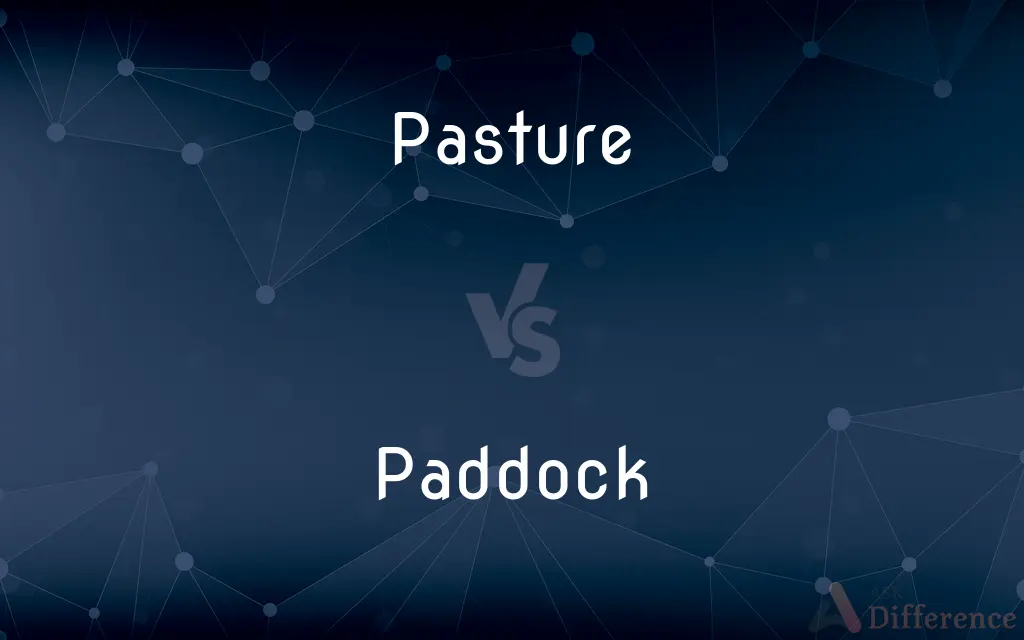Pasture vs. Paddock — What's the Difference?
By Fiza Rafique & Maham Liaqat — Updated on March 28, 2024
Pasture is land covered with grass and plants suitable for grazing animals, while a paddock is a smaller, enclosed area for grazing or exercising animals.

Difference Between Pasture and Paddock
Table of Contents
ADVERTISEMENT
Key Differences
Pasture refers to open land with natural or planted grasses and forbs, used for grazing livestock such as cattle, sheep, and horses. It's an integral part of the agricultural landscape, often managed to maintain the health of the grass and soil, ensuring sustainable feed for grazing animals. Paddocks, on the other hand, are smaller, fenced sections within a pasture or farm designed to control the movement and grazing patterns of animals. They are used not only for grazing but also for training, exercising, or isolating animals for various management purposes.
The management of pasture involves practices such as rotational grazing, mowing, and sometimes fertilization to promote regrowth and prevent overgrazing. In contrast, paddock management focuses on rotating animals between paddocks to allow grass recovery, minimizing the risk of soil compaction and erosion, and maintaining animal health through controlled grazing.
Pastures play a crucial role in biodiversity, supporting a variety of flora and fauna, while paddocks, due to their enclosed nature, have more controlled environments. Paddocks are often part of a larger pasture management strategy, allowing for more intensive monitoring and management of the animals' health and the land's condition.
While pastures are primarily defined by their use for grazing, paddocks may serve multiple functions beyond grazing, including as safe enclosures for young, sick, or newly introduced animals to a herd. The scale and use of pastures and paddocks vary, with pastures covering larger areas that can sustain animals for much of the year, and paddocks providing more specific, controlled conditions for grazing, exercise, or isolation.
Both pastures and paddocks are essential for the effective management of livestock, but they serve different roles within an agricultural or equestrian setting. Pastures offer a natural environment for animals to graze and exercise, while paddocks provide a more controlled setting for specialized activities, health management, or intensive grazing management practices.
ADVERTISEMENT
Comparison Chart
Definition
Land with grasses and plants for grazing animals.
A smaller, enclosed area within a farm for animals.
Primary Use
Grazing livestock like cattle, sheep, and horses.
Grazing, exercising, or isolating animals.
Size
Generally larger, open fields.
Smaller, enclosed sections of land.
Management Practices
Rotational grazing, mowing, fertilization.
Rotating animals, controlling grazing to prevent overuse.
Biodiversity
Supports a wide range of flora and fauna.
More controlled environment, limited biodiversity.
Functions Beyond Grazing
Primarily for grazing.
May include training, rehabilitation, or quarantine.
Role in Agriculture
Sustains livestock, part of broader land management.
Part of livestock management strategy, detailed control.
Environmental Impact
Promotes soil health and biodiversity when managed well.
Helps prevent soil compaction and erosion through rotation.
Compare with Definitions
Pasture
Managed to ensure sustainable feed for grazing animals.
They implemented rotational grazing in the pasture to prevent overgrazing.
Paddock
A fenced area on a farm used for grazing or exercising animals.
She led the horse into the paddock for its daily exercise.
Pasture
Land covered with grass and other plants for feeding livestock.
The cattle roamed the vast pasture in search of fresh grass.
Paddock
Smaller than pastures, often for specific management tasks.
The sick cow was isolated in a paddock near the barn.
Pasture
Contributes to the ecosystem's biodiversity.
The pasture was alive with wildflowers and birds, alongside grazing sheep.
Paddock
Can serve as training or rehabilitation areas.
The young colts were trained in the paddock before being introduced to larger fields.
Pasture
Requires monitoring and management for soil health.
To improve the pasture, they seeded it with a mix of grasses.
Paddock
Part of rotational grazing strategies.
Moving sheep between paddocks helped keep the grass at an optimal height.
Pasture
A natural environment for animals.
The horses thrived in the open pasture, benefiting from the natural forage.
Paddock
Essential for controlled grazing and animal health.
The paddock system allowed for better monitoring of each animal's health.
Pasture
Pasture (from the Latin pastus, past participle of pascere, "to feed") is land used for grazing. Pasture lands in the narrow sense are enclosed tracts of farmland, grazed by domesticated livestock, such as horses, cattle, sheep, or swine.
Paddock
A paddock is a small enclosure for horses. In the United Kingdom, this term also applies to a field for a general automobile racing competition, particularly Formula 1.
Pasture
Land covered with grass and other low plants suitable for grazing animals, especially cattle or sheep
Areas of rich meadow pasture
Grassy pastures
Many a horse was put out to pasture there
A range of pasture grasses
Paddock
A fenced area, usually near a stable, used chiefly for grazing horses.
Pasture
Used to refer to a person's situation in life
She left the office for pastures new
Paddock
An enclosure at a racetrack where the horses are assembled, saddled, and paraded before each race.
Pasture
Put (animals) to graze in a pasture
They pastured their cows in the water meadow
Paddock
An area of an automobile racetrack where cars are prepared before a race.
Pasture
A tract of land that supports grass or other vegetation eaten by domestic grazing animals.
Paddock
(Australian) A piece of fenced-in land.
Pasture
Such vegetation, especially that eaten by domestic grazing animals.
Paddock
To confine in a paddock.
Pasture
The feeding or grazing of animals.
Paddock
A small enclosure or field of grassland, especially one used to exercise or graze horses or other animals.
Pasture
To herd (animals) into a pasture to graze.
Paddock
(by extension)
Pasture
To provide (animals) with pasturage. Used of land.
Paddock
(horse racing) An enclosure next to a racecourse where horses are paraded and mounted before a race and unsaddled after a race.
Pasture
To graze on (land or vegetation).
Paddock
(motor racing) An area at a racing circuit where the racing vehicles are parked and worked on before and between races.
Pasture
To use (land) as pasture.
Paddock
A field on which a game is played; a playing field.
Pasture
To graze in a pasture.
Paddock
A field of grassland of any size, either enclosed by fences or delimited by geographical boundaries, especially a large area for keeping cattle or sheep.
Pasture
Land, specifically, an open field, on which livestock is kept for feeding.
Paddock
A place in a superficial deposit where ore or washing]] is excavated; also, a place for storing ore, washdirt, etc.
Pasture
Ground covered with grass or herbage, used or suitable for the grazing of livestock.
Paddock
A frog.
Cold as a paddock.
Pasture
(obsolete) Food, nourishment.
Paddock
A toad.
Pasture
(transitive) To move animals into a pasture.
Paddock
(derogatory) A contemptible, or malicious or nasty, person.
Pasture
(intransitive) To graze.
Paddock
(Scotland) A simple, usually triangular, sledge which is dragged along the ground to transport items.
Pasture
(transitive) To feed, especially on growing grass; to supply grass as food for.
The farmer pastures fifty oxen.
The land will pasture forty cows.
Paddock
To place or keep (cattle, horses, sheep, or other animals) within a paddock (noun sense 1 or 2.4); hence, to provide (such animals) with pasture.
Pasture
Food; nourishment.
Toads and frogs his pasture poisonous.
Paddock
To enclose or fence in (land) to form a paddock.
Pasture
Specifically: Grass growing for the food of cattle; the food of cattle taken by grazing.
Paddock
(mining)
Pasture
Grass land for cattle, horses, etc.; pasturage.
He maketh me to lie down in green pastures.
So graze as you find pasture.
Paddock
To excavate washing]] from (a superficial deposit).
Pasture
To feed, esp. to feed on growing grass; to supply grass as food for; as, the farmer pastures fifty oxen; the land will pasture forty cows.
Paddock
(obsolete) To store (ore, washdirt, etc.) in a paddock (noun sense 2.5).
Pasture
To feed on growing grass; to graze.
Paddock
A toad or frog.
Pasture
A field covered with grass or herbage and suitable for grazing by livestock
Paddock
A small inclosure or park for sporting.
Pasture
Animal food for browsing or grazing
Paddock
A small inclosure for pasture; esp., one adjoining a stable.
Pasture
Let feed in a field or pasture or meadow
Paddock
An enclosure used for saddling and mounting horses prior to a race.
Pasture
Feed as in a meadow or pasture;
The herd was grazing
Paddock
Pen where racehorses are saddled and paraded before a race
Common Curiosities
Why are paddocks important in livestock management?
Paddocks allow for controlled grazing, isolation of animals for health or training, and help manage land more effectively to prevent overuse.
Can paddocks be part of a pasture?
Yes, paddocks can be sections within a pasture, enclosed for specific management purposes like rotational grazing.
What management practices are common in pasture management?
Practices include rotational grazing, mowing to control plant growth, and fertilization to maintain soil fertility and grass quality.
How do pastures contribute to biodiversity?
Pastures provide habitats for various plant species and wildlife, contributing to the ecosystem's overall health and diversity.
How does rotational grazing work?
Rotational grazing involves moving livestock between different areas (paddocks) to allow grass in previously grazed areas to regrow and prevent overgrazing.
Are paddocks used only for grazing?
No, paddocks can also be used for exercising, training, or isolating animals for health and management reasons.
How do paddocks help in preventing soil erosion?
By rotating animals between paddocks, the land has time to recover, reducing the risk of soil compaction and erosion.
Can both pastures and paddocks be used in any type of farming?
Yes, both are versatile and can be adapted to various types of farming, including dairy, beef, sheep, and horse farming.
What is the main difference between a pasture and a paddock?
The main difference is size and function; pastures are larger areas for grazing, while paddocks are smaller, enclosed areas for more controlled activities.
Why might a farmer choose to use paddocks within a pasture?
A farmer might use paddocks to manage grazing more effectively, improve land utilization, and enhance the health and productivity of both livestock and pasture.
Share Your Discovery

Previous Comparison
Announcement vs. Poster
Next Comparison
Swimming vs. GymnasticsAuthor Spotlight
Written by
Fiza RafiqueFiza Rafique is a skilled content writer at AskDifference.com, where she meticulously refines and enhances written pieces. Drawing from her vast editorial expertise, Fiza ensures clarity, accuracy, and precision in every article. Passionate about language, she continually seeks to elevate the quality of content for readers worldwide.
Co-written by
Maham Liaqat















































